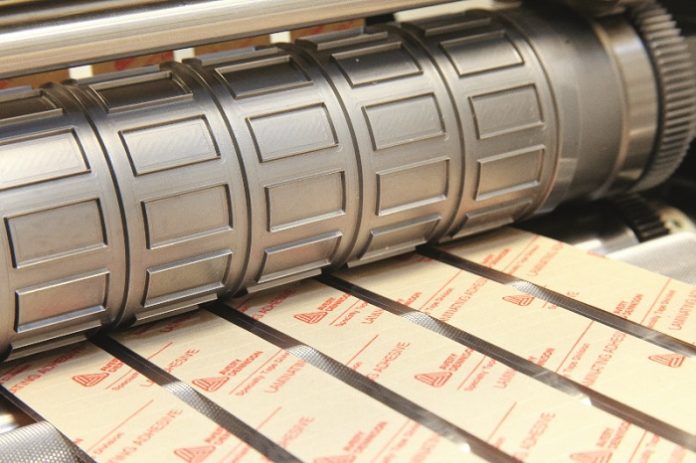
We can never be too safe. In the box plant, hazardous situations are waiting around every corner, so it’s important to be educated and aware of these hazards — even something as simple as cutting dies, items which are so routine that we never give them a second thought.
In the corrugated manufacturing environment great emphasis is placed on the hazards of moving machinery. However, tooling hazards typically do not receive the same level of attention. Tooling such as cutting dies presents potential hazards through out its life cycle. Understanding these hazards and educating the workforce can greatly reduce the opportunity for injury.
Let’s look at the cutting die
First of all the name of the tool should alert us to potential danger. The cutting die. It cuts, and it doesn’t discriminate between hands, fingers or board. The razor sharp knives present the opportunity for very serious and painful cuts. Everyone who may come into contact with dies must be aware of the potential hazards and the proper way to handle them.
Storage
The safest way to store dies is horizontally in specially designed die racks. These racks protect the die from damage and provide additional protection for plant personnel. Horizontal storage also makes the die easier to handle reducing the risk of muscle strain.
Storing dies vertically, even for the short-term, can be very dangerous to plant personnel and significantly increase the chance of damaging the dies. If dies must be stored vertically, they should be secured with a chain about 2/3 of the shell height from the floor. This will minimize, but not eliminate, the chance of a domino effect collapse. Such a collapse can cause great damage to the dies and severely injure anyone in the area. If a die starts to fall, get out of the way and let it go. All of us would much rather make a trip to the die shop than the Emergency room.
Transportation
Special care should be taken whenever transporting dies. Special carts, some with electric or hydraulic lifts, are available for this purpose. These carts minimize the chance of strain or injury and allow one person to safely transport the die through the plant. Dies should never be dragged through the plant. In addition to damaging the die, this presents a trip hazard to any one who doesn’t see the die trailing behind you.
Mounting
Mounting and demounting the die is perhaps where most injuries occur. Here the crew has the closest and most prolonged exposure to the unprotected knife. Keeping alert and practising a few simple rules can greatly reduce the chance of injury during mounting and demounting.
First, when entering the machine to change a die, ensure all machine safety procedures have been followed. This may include lockout/tagout, disabling the open/close circuit and safety key initiation. If the machine requires the operator to stand on or cross a conveyor, make sure it is turned off and, if applicable, the automatic mode is disabled to prevent the conveyor from inadvertently starting. Also, never walk on conveyor rollers, especially when carrying a die.
Dies can be very heavy. Large dies or those with heavy concentration of rule can easily weigh upwards of 60 pounds (27 kilograms). Their size can also make them rather cumber some. A good rule of thumb is dies over 60 inches long, or weighing over 50 pounds (22 kilograms), should be handled by two people. This greatly reduces the chance of injury from muscle strain and accident.
Remember that knife and rule are not handles. Never push on the rule or knife. When placing the die on the cylinder it is often necessary to index the die slightly to align bolt holes. Use the hand holes cut in the die to adjust the position. Don’t use excessive force here either. If your hand should slip, it can still result in an injury. If the die is tight, gently tap the edge with a soft mallet to position it.
Generally when tightening die bolts, an air wrench is safer than a ratchet. If you use a ratchet, don’t apply excessive force. Slipping or tool failure could result in a serious cut. Protective, cut resistant gloves (available from most die supply companies) should be worn when handling dies. Many plants require this as part of their safety programme.
The old diecutter’s rule, ‘a bolt in every hole,’ not only extends the life of the die, but makes it far less likely for the die to come off during high-speed production. If this happens, the die or pieces of it can become high velocity projectiles with the capability of causing injury to any one working in the vicinity. Although not the subject of this article, it’s worth pointing out that mounting dies with ‘a bolt in every hole’ has a very positive effect on diecutting accuracy and repeatability.
Special care should be taken when mounting dies with less than 180 degrees of shell wrap. Operators may develop a habit of placing a die on the cylinder then reaching for the wrenchor bolts. These dies have a tendency to fall off if released before they are secured to the cylinder. All dies should be firmly secured with at least two bolts before they are released. A die that falls from a cylinder can cause severe injury to legs and feet as well as arms and hands.
There are many quick mounting systems available for cutting dies. These systems usually require a special procedure to mount, often requiring the die to be placed onto the cylinder and then indexed into the locking position. If special tools are available from the supplier, they should be used for safety and convenience.
Die repair and maintenance
As well as being key to the quality of your product, keeping your dies in good repair contributes to safe use. When inspecting dies, pay special attention to areas that contain small pieces of rule or knife. If the shell is damaged, and sometimes simply on their own, small pieces of knife can work loose or break away and become projectiles.
Most plants today require the use of safety glasses when on the manufacturing floor. This point should be reinforced when performing maintenance. While grinding, nicking or even pounding rule into the shell, pieces can break off or deflect and become airborne.
While it may not be feasible to completely eliminate the risk of injury from tooling such as cutting dies, slitting knives, and more, educating all box plant workers of the potential hazards and promoting safe work habits will greatly reduce the chances of serious injury.
Ron Rauschart is the vice president of sales for Dicar, Inc. of Pine Brook, NJ. Founded in 1969, Dicar, Inc. is a leading manufacturer of urethane products for the corrugated container industry, with an emphasis on anvil covers for rotary diecutting. Dicar, Inc. is also very involved in on-site training for operators of rotary diecutters. To contact Ron or Dicar, Inc. call 1-800-323-4227, or visit www.dicar.com.











